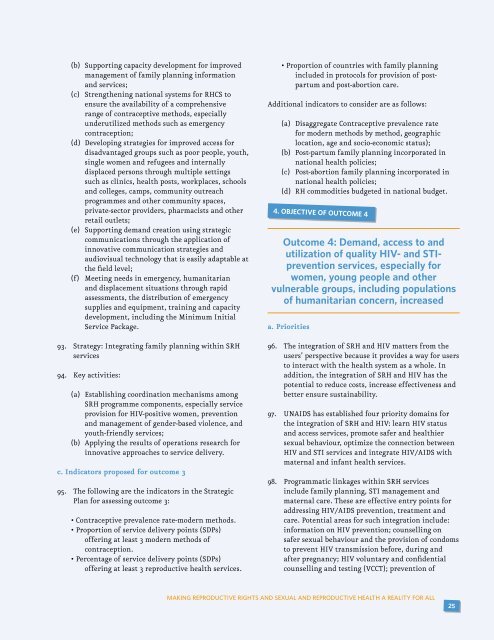Sexual and Reproductive Health Framework - UNFPA
Sexual and Reproductive Health Framework - UNFPA
Sexual and Reproductive Health Framework - UNFPA
Create successful ePaper yourself
Turn your PDF publications into a flip-book with our unique Google optimized e-Paper software.
(b) Supporting capacity development for improvedmanagement of family planning information<strong>and</strong> services;(c) Strengthening national systems for RHCS toensure the availability of a comprehensiverange of contraceptive methods, especiallyunderutilized methods such as emergencycontraception;(d) Developing strategies for improved access fordisadvantaged groups such as poor people, youth,single women <strong>and</strong> refugees <strong>and</strong> internallydisplaced persons through multiple settingssuch as clinics, health posts, workplaces, schools<strong>and</strong> colleges, camps, community outreachprogrammes <strong>and</strong> other community spaces,private-sector providers, pharmacists <strong>and</strong> otherretail outlets;(e) Supporting dem<strong>and</strong> creation using strategiccommunications through the application ofinnovative communication strategies <strong>and</strong>audiovisual technology that is easily adaptable atthe field level;(f) Meeting needs in emergency, humanitarian<strong>and</strong> displacement situations through rapidassessments, the distribution of emergencysupplies <strong>and</strong> equipment, training <strong>and</strong> capacitydevelopment, including the Minimum InitialService Package.93. Strategy: Integrating family planning within SRHservices94. Key activities:(a) Establishing coordination mechanisms amongSRH programme components, especially serviceprovision for HIV-positive women, prevention<strong>and</strong> management of gender-based violence, <strong>and</strong>youth-friendly services;(b) Applying the results of operations research forinnovative approaches to service delivery.c. Indicators proposed for outcome 395. The following are the indicators in the StrategicPlan for assessing outcome 3:• Contraceptive prevalence rate-modern methods.• Proportion of service delivery points (SDPs)offering at least 3 modern methods ofcontraception.• Percentage of service delivery points (SDPs)offering at least 3 reproductive health services.• Proportion of countries with family planningincluded in protocols for provision of postpartum<strong>and</strong> post-abortion care.Additional indicators to consider are as follows:(a) Disaggregate Contraceptive prevalence ratefor modern methods by method, geographiclocation, age <strong>and</strong> socio-economic status);(b) Post-partum family planning incorporated innational health policies;(c) Post-abortion family planning incorporated innational health policies;(d) RH commodities budgeted in national budget.4. objective of outcome 4Outcome 4: Dem<strong>and</strong>, access to <strong>and</strong>utilization of quality HIV- <strong>and</strong> STIpreventionservices, especially forwomen, young people <strong>and</strong> othervulnerable groups, including populationsof humanitarian concern, increaseda. Priorities96. The integration of SRH <strong>and</strong> HIV matters from theusers’ perspective because it provides a way for usersto interact with the health system as a whole. Inaddition, the integration of SRH <strong>and</strong> HIV has thepotential to reduce costs, increase effectiveness <strong>and</strong>better ensure sustainability.97. UNAIDS has established four priority domains forthe integration of SRH <strong>and</strong> HIV: learn HIV status<strong>and</strong> access services, promote safer <strong>and</strong> healthiersexual behaviour, optimize the connection betweenHIV <strong>and</strong> STI services <strong>and</strong> integrate HIV/AIDS withmaternal <strong>and</strong> infant health services.98. Programmatic linkages within SRH servicesinclude family planning, STI management <strong>and</strong>maternal care. These are effective entry points foraddressing HIV/AIDS prevention, treatment <strong>and</strong>care. Potential areas for such integration include:information on HIV prevention; counselling onsafer sexual behaviour <strong>and</strong> the provision of condomsto prevent HIV transmission before, during <strong>and</strong>after pregnancy; HIV voluntary <strong>and</strong> confidentialcounselling <strong>and</strong> testing (VCCT); prevention ofMAKING REPRODUCTIVE RIGHTS AND SEXUAL AND REPRODUCTIVE HEALTH A REALITY FOR ALL25
















